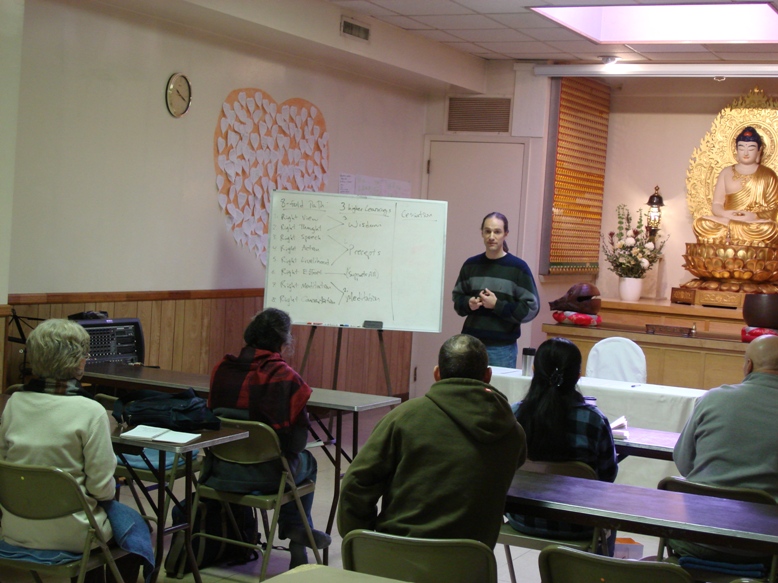| |

Dharma 101: The Four Noble Truths
By Chang Jie
03/07/2009 - 03/21/09
 On three consecutive Saturdays, March 7, 14, and 21, 2009, Dr. David Slaymaker taught a class on
introductory concepts in Buddhism, titled, "Dharma 101: The Four Noble Truths' at CMC. The class
was based on Master Sheng Yen’s booklet, "Setting in Motion the Dharma Wheel". Dr. Slaymaker used
an interactive and experiential approach to teaching this subject.
On three consecutive Saturdays, March 7, 14, and 21, 2009, Dr. David Slaymaker taught a class on
introductory concepts in Buddhism, titled, "Dharma 101: The Four Noble Truths' at CMC. The class
was based on Master Sheng Yen’s booklet, "Setting in Motion the Dharma Wheel". Dr. Slaymaker used
an interactive and experiential approach to teaching this subject.
At the first class, Dr. Slaymaker introduced the Four Noble Truths. There are two aspects of the
teachings: 1) the concepts and methods, and 2) realization. We should try to bridge knowledge
and insights to help decrease suffering.

Dr. Slaymaker explained the Four Noble Truths are the existence of suffering, the cause of suffering,
the cessation of suffering, and the method of cessation of suffering. The purpose of understanding
the Four Noble Truths is to reduce, alleviate and ultimately uproot suffering. Understanding suffering
may help us to build aspiration to end suffering.
In order to guide our understanding of suffering, Dr. Slaymaker used the example of experiencing a
headache and asked the following questions:
- Where is the suffering occurring? (eg: Does it occur in the body or mind?)
- How do we characterize the suffering? What is the nature of the suffering? (eg: fear, sadness, guilt, distraction)
- Is it okay to suffer?
- Can pain occur without suffering?
- How do we view suffering?
- How can we find joy in suffering?
For homework, the audience was asked to look deeply at their own suffering in everyday life, label it, notice when we do not suffer,
see how suffering affects our lives and those around us, and how suffering motivates us.
During the second class, he talked about the causes of suffering, which are in the mind. Because suffering is in the mind, we are
responsible for the causes of our suffering and for the alleviation of our suffering. The causes of suffering are craving (desire,
grasping, attachment), aversion (hatred, ill-will) and ignorance (misunderstanding of the processes of the mind). During the third
class, he talked about the cessation of suffering, or the attainment of nirvana, through the method of the cessation of suffering -
the Eightfold Path.
References:
Master Sheng Yen: Setting in Motion the Dharma Wheel. http://www.chan1.org/ddp/talks/dharmawheel.html
This booklet is free and available at CMC.
|
|